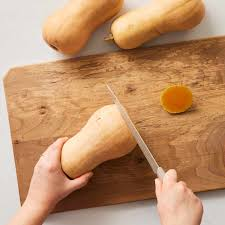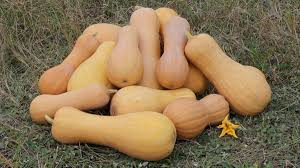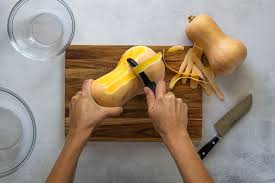Butternut squash is a popular choice among gardeners for several reasons. Not only do its vines resist the common pest, squash vine borers, but the squash itself stores well. After harvesting, simply cure the mature squash in a warm area for a few weeks, then move it to a cool, dry place. Properly stored, a butternut squash can last six months or even longer. Many gardeners also favor butternut squash for its sweet, moist flesh, which has a deeper orange color compared to other winter squash varieties.
However, cutting and peeling butternut squash can be tricky, especially for those unfamiliar with its tough skin and firm texture. In this guide, we’ll cover the best methods for cutting and peeling butternut squash to make your preparation process easier and more efficient.
How to Cut Butternut Squash
How you cut the squash depends on what you’re preparing. If you’re roasting or stuffing, cutting the squash in half works best. Begin by trimming both ends off the squash. Stand it upright on its flat end and use a sharp knife to slice it vertically down the middle. After splitting the squash, scoop out the seeds with a melon baller or a grapefruit spoon.
If you’re looking to cube the squash for roasting or soup, it’s best to peel it first. The key to peeling butternut squash is using a vegetable peeler. While you might think a knife is the best tool, a peeler is actually more efficient. It can navigate the squash’s curved surfaces with ease and removes the skin at the perfect depth. Start by cutting off the bottom of the squash, which gives you a flat surface to work with. From there, you can use the peeler to remove the skin in long ribbons, moving towards you.

For comparison, I timed how long it took to peel and cut butternut squash with both a peeler and a knife. The knife took longer and resulted in more waste, with chunks of usable flesh ending up in the compost. The peeler, on the other hand, was faster and left more of the squash intact.
Avoid Microwave Peeling Methods
You may have encountered instructions online recommending that you microwave the squash to make peeling easier. However, this method can lead to frustration. The idea is to cut off both ends, poke the rind several times with a fork, and microwave the squash for a few minutes. Supposedly, this softens the squash and makes it easier to peel. Unfortunately, in practice, the rind sticks to the flesh, making peeling more difficult and messy.

Tips for Dealing with Squash Residue
One challenge when cutting and peeling butternut squash is the sticky, latex-like residue that can coat your hands. This substance can be difficult to wash off and may leave your hands looking as though you’ve developed a strange skin condition. To remove the residue, the most effective method is to use pieces of clear packing tape to peel it off. If you don’t have tape on hand, you’ll just have to wait, as the residue will eventually wear off on its own.
Conclusion
Cutting and peeling butternut squash doesn’t have to be a hassle. With the right tools and techniques, you can easily prepare your squash for cooking. Remember to use a vegetable peeler for efficiency and avoid the microwave method, which is more trouble than it’s worth. With these tips, you’ll be ready to enjoy the sweet, creamy flesh of butternut squash in all your favorite dishes.
